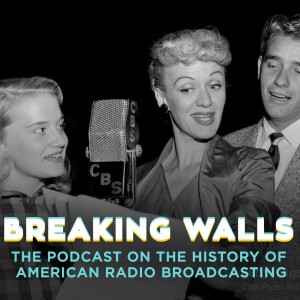
BW - EP143—001: September 1957—The Man From Tomorrow
 2023-08-31
2023-08-31
Download
Right click and do "save link as"
August, 1957.
We’re driving east on Route 50 from West Sacramento in a 1957 Ford Skyliner. The convertible costs roughly three-thousand dollars, has a Y-block Thunderbird V-8 engine and two-hundred-twelve horsepower.
It’s got something else too: car radios have become Standard. U.S. Radio Magazine will soon state that fifty-five percent of all peak listening came from cars. Auto-rating measurements are underway, but still ineffective.
Radio stations are having a good year. Sixty percent of National stations expect their total revenue to grow. Total radio revenue is expected to increase three percent year-over-year. A median station in 1957 is expected to make nearly one-hundred-three thousand dollars in revenue, with a profit of eleven-thousand five-hundred dollars.
Urban stations are enjoying higher numbers thanks to higher populations and more national ad spots, though local sponsors are paying eighty-seven percent of ad costs.
Programming accounts for thirty-three percent of all expenses.
Gunsmoke was dramatic radio’s highest-rated show, with its Saturday afternoon repeat broadcast attracting even more listeners than its Sunday evening primetime installment. Somewhere between four and five million people were still tuning in from their homes. When factoring in car and transistor radios, nearly ten million people were listening.
Meanwhile, Major David Simons just piloted the first hot-air balloon to reach over one-hundred-thousand feet of altitude, skirting the outer rim of our atmosphere.
With the experiment lasting more than twenty-four hours, it was the precursor to manned space flights.
On August 28th, the Major appeared on LIFE And The World over NBC radio in conjunction with the September 2nd, issue of LIFE Magazine.
The rocket age, the Cold War, integration and civil rights are all upon us, while radio drama hangs on for dear life.
Tonight, we’ll step into a portal to a time with Elvis Presley, Buddy Holly, and Fibber McGee and Molly. And along the way, we might just remember where we’ve been, so we know where we’re going.
___________
On June 1st, 1957 after three seasons as a five-a-week serial, Jim and Marian Jordan joined NBC’s Monitor in short segments. The Monitor service had been airing for two years, offering NBC affiliates a full weekend block of available programming.
In New York, On Sunday September 1st, NBC’s WRCA began airing Monitor at 12PM. That day Fibber and Molly told a version of their origin story. In 1958, tests found that Marian had a terminal form of cancer. She continued to work as long as possible. The couple had vignettes on Monitor until September of 1959.
Fibber McGee and Molly were the subject of Breaking Walls episode 103.
If you’d have tuned into WCBS in New York on Sunday, September 1st, 1957 you’d have heard news reports at the tops of most hours. Concerts and other music programs filled the dial between 11:30AM and 4:00PM. At 4:05 The CBS Radio Workshop signed on with the network’s first dramatic offering of the day.
Next up was Suspense. In 1957 William N. Robson was in the middle of a three year run as director. CBS had found multiple sponsorship for the series in late 1956. Ten months later, it was airing on Sundays at 4:35 from WCBS in New York, and at 4PM from KNX in Los Angeles.
By 1957 Robson had more than twenty years of experience writing, producing, and directing radio shows. The September 1st episode was called “The Man From Tomorrow.” It starred Frank Lovejoy and Joan Banks. At that time, they’d been married for seventeen years.
One thing that was most certainly successful: CBS’s handling of radio during the oncoming TV era. A large part of this was because of chairman William Paley’s belief in the medium. By 1957 he’d been head of CBS for thirty years.
At the CBS company convention in November of 1957 upper management predicted that radio was becoming fashionable again.
view more
More Episodes
012345678910111213141516171819
Create your
podcast in
minutes
- Full-featured podcast site
- Unlimited storage and bandwidth
- Comprehensive podcast stats
- Distribute to Apple Podcasts, Spotify, and more
- Make money with your podcast
It is Free
- Privacy Policy
- Cookie Policy
- Terms of Use
- Consent Preferences
- Copyright © 2015-2024 Podbean.com






